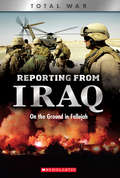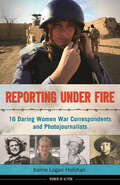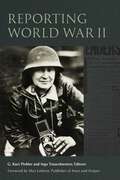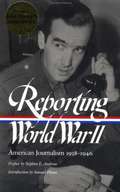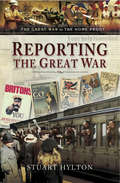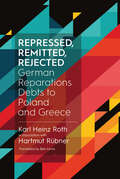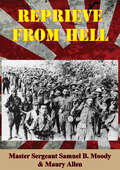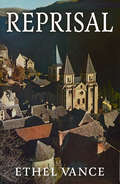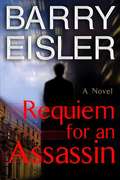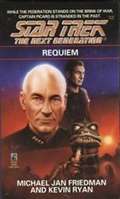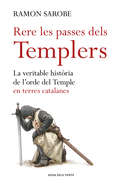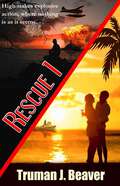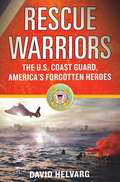- Table View
- List View
Reporters on the Battlefield: Combat Stress Reactions and Their Implications for Urban Warfare
by Christopher Paul James J. KimFocusing on the embedded press system deployed during Operation Iraqi Freedom, this book attempts to answer the following questions: How effective was the embedded press system in meeting the needs of the three main constituencies-the press, the military, and the citizens of the United States? What policy history led to the innovation of an embedded press system? Where are press-military relations likely to go in the future?
Reporting From Iraq: On The Ground In Fallujah (Xbooks)
by Candy J. CooperReporting from the ground in Fallujah!High-interest topics, real stories, engaging design and astonishing photos are the building blocks of the XBooks, a new series of books designed to engage and motivate reluctant and enthusiastic readers alike. With topics based in science, history, and social studies, these action-packed books will help students unlock the power and pleasure of reading... and always ask for more!Anne Garrels was a brave news journalist reporting on the war in Iraq. She carried out dangerous missions to keep the public informed and to share first-hand accounts of life in the First Battalion.
Reporting Under Fire: 16 Daring Women War Correspondents and Photojournalists
by Kerrie HollihanThe tremendous struggles women have faced as war correspondents and photojournalists A profile of 16 courageous women, Reporting Under Fire tells the story of journalists who risked their lives to bring back scoops from the front lines. Each woman--including Sigrid Schultz, who broadcast news via radio from Berlin on the eve of the Second World War; Margaret Bourke-White, who rode with General George Patton's Third Army and brought back the first horrific photos of the Buchenwald concentration camp; and Marguerite Higgins, who typed stories while riding in the front seat of an American jeep that was fleeing the North Korean Army--experiences her own journey, both personally and professionally, and each draws her own conclusions. Yet without exception, these war correspondents share a singular ambition: to answer an inner call driving them to witness war firsthand, and to share what they learn via words or images.
Reporting War: How Foreign Correspondents Risked Capture, Torture and Death to Cover World War II
by Ray MoseleyThis &“excellent, wonderfully-researched&” chronicle of WWII journalism explores the lives and work of embedded reporters across every theater of war (Chris Ogden, former Time magazine bureau chief in London). Luminary journalists Ed Murrow, Martha Gellhorn, Walter Cronkite, and Clare Hollingworth were among the young reporters who chronicled World War II&’s daily horrors and triumphs for Western readers. In Reporting War, fellow foreign correspondent Ray Moseley mines their writings to create an exhilarating parallel narrative of the war effort in Europe, Pearl Harbor, North Africa, and Japan. This vivid history also explores the lives, methods, and motivations of the courageous journalists who doggedly followed the action and the story, often while embedded in the Allied armies. Moseley&’s sweeping yet intimate history draws on newly unearthed material to offer a comprehensive account of the war. Reporting War sheds much-needed light on an abundance of individual stories and overlooked experiences, including those of women and African-American journalists, which capture the drama as it was lived by reporters on the front lines of history.
Reporting World War II (World War II: The Global, Human, and Ethical Dimension)
by G. Kurt Piehler and Ingo TrauschweizerThis set of essays offers new insights into the journalistic process and the pressures American front-line reporters experienced covering World War II. Transmitting stories through cable or couriers remained expensive and often required the cooperation of foreign governments and the American armed forces. Initially, reporters from a neutral America documented the early victories by Nazi Germany and the Soviet invasion of Finland. Not all journalists strove for objectivity. During her time reporting from Ireland, Helen Kirkpatrick remained a fierce critic of that country’s neutrality. Once the United States joined the fight after the Japanese attack on Pearl Harbor, American journalists supported the struggle against the Axis powers, but this volume will show that reporters, even when members of the army sponsored newspaper, Stars and Stripes were not mere ciphers of the official line.African American reporters Roi Ottley and Ollie Stewart worked to bolster the morale of Black GIs and undermined the institutional racism endemic to the American war effort. Women front-line reporters are given their due in this volume examining the struggles to overcome gender bias by describing triumphs of Thérèse Mabel Bonney, Iris Carpenter, Lee Carson, and Anne Stringer.The line between public relations and journalism could be a fine one as reflected by the U.S. Marine Corps’ creating its own network of Marine correspondents who reported on the Pacific island campaigns and had their work published by American media outlets. Despite the pressures of censorship, the best American reporters strove for accuracy in reporting the facts even when dependent on official communiqués issued by the military. Many wartime reporters, even when covering major turning points, sought to embrace a reporting style that recorded the experiences of average soldiers. Often associated with Ernie Pyle and Bill Mauldin, the embrace of the human-interest story served as one of the enduring legacies of the conflict.Despite the importance of American war reporting in shaping perceptions of the war on the home front as well as shaping the historical narrative of the conflict, this work underscores how there is more to learn. Readers will gain from this work a new appreciation of the contribution of American journalists in writing the first version of history of the global struggle against Nazi Germany, imperial Japan, and fascist Italy.
Reporting World War II: American Journalism 1938-1946
by Samuel Hynes Nancy Caldwell Sorel Anne Matthew Roger J. SpillerHere, for the first time in paperback, the work of more than 50 remarkable reporters has been drawn from original newspaper and magazine reports, radio transcripts, and wartime books to capture the intensity of World War II's unfolding drama.
Reporting from the Front: War Reporters During the Great War
by Brian BestWhen the war was declared in August 1914, one of the first acts to be implemented by the politicians and military was a strict censorship on the newspapers. As the poacher turned gamekeeper, Winston Churchill said: The war is going to be fought in a fog and the best place for correspondence about the war is London, The military sought to have one of their officers, dubbed &“Eyewitness&”, to be the official spokesman to enable them to control what the newspapers could print. In the early stages of the war, there were many reporters on the Continent who were evading military arrest and sending back reports about the reality of the situation. Several volunteered with the various ambulance services just to disguise their real purpose, but all were eventually banished. Having finally cleared all reporters from fighting area, the military was persuaded to allow a small number of accredited war reporters to be chaperoned around the battle fronts. They were closely watched and their reports thoroughly scrutinised, until they eventually became almost a part of the Headquarters hierarchy. Later, diaries and letters revealed how many of them really felt and they had to bear the post-war shame of not writing the truth. The Western Front was not the only front in this world war. Reporters found censorship less rigidly applied on the Eastern Front, Palestine and Italy. One correspondent, whose reports famously brought about the sacking of the campaign commander and the ending of the fruitless and bloody Gallipoli Expedition, bravely broke ranks and was finished as a war reporter. War reporting was not confined to print. The emergence of photographers and cinematographers on the battlefield has left us with an extraordinary record. Unlike their writing brothers, the photographers could get close to the action and shoot what they liked. The resultant film was, of course, censored but thankfully nothing was discarded and museum archives are full of their stunning work. Having been the pre-war stars of their newspapers, the war reporters experienced a post-war wave of anger and cynicism which took years to overcome.
Reporting the First World War in the Liminal Zone: British And American Eyewitness Accounts From The Western Front
by Sara PrietoThis book deals with an aspect of the Great War that has been largely overlooked: the war reportage written based on British and American authors’ experiences at the Western Front. It focuses on how the liminal experience of the First World War was portrayed in a series of works of literary journalism at different stages of the conflict, from the summer of 1914 to the Armistice in November 1918.Sara Prieto explores a number of representative texts written by a series of civilian eyewitness who have been passed over in earlier studies of literature and journalism in the Great War. The texts under discussion are situated in the ‘liminal zone’, as they were written in the middle of a transitional period, half-way between two radically different literary styles: the romantic and idealising ante bellum tradition, and the cynical and disillusioned modernist school of writing. They are also the product of the various stages of a physical and moral journey which took several authors into the fantastic albeit nightmarish world of the Western Front, where their understanding of reality was transformed beyond anything they could have anticipated.
Reporting the Great War (The Great War on the Home Front)
by Stuart HyltonThe Great War of 1914–1918 was the world's first total conflict. It drew the whole population into the war effort as never before. The armed forces recruited on a scale that was previously unimaginable, and the munitions industries drew more and more citizens into the labour market. The entire national economy was thrown onto a war footing. The local newspapers of those years provide a unique picture of these momentous changes, and Reporting the Great War uses their words to recapture the experience of the time. It illustrates in telling detail the human tragedies and triumphs of a nation at war and the day-to-day preoccupations of communities trying to find normality during an unprecedented emergency. Sections of the population were gripped by 'hun-phobia' the fear that everything Germanic was an agent of the enemy. Terror of aerial attack and the shortages caused by the German submarine blockade brought the reality of war close to home. Unfamiliar terms entered the national vocabulary conscription, conscientious objection, rationing and pre-war assumptions, from the role of women to the use of alcohol, were challenged and changed.Stuart Hylton's fascinating account of the British home front during the Great War, as it was seen through the newspaper columns of the day, shows a nation seemingly sleepwalking into a war in 1914 and emerging, four years later, with the hope that a better world would come with the peace.
Reporting the Second World War
by Brian BestAfter a slow start, the Second World War produced an enormous number of war correspondents. Correspondents like Ernest Hemingway, John Dos Passos and George Orwell were all inspired to put their experiences on the printed page. Hemingway and his wife, Martha Gellhorn, went on to cover the D-Day Landings and the final victory in Germany.The British Broadcasting Corporation was the first to use live broadcasts from the front. Encouraged by the RAF's favourable acceptance of Richard Dimbleby's commentary from the flight deck of a Lancaster bomber over Berlin, which was piloted by the legendary Guy Gibson VC, the public's reaction was overwhelmingly positive.Increasingly, war correspondents sought danger by flying bombing missions, parachuting with airborne forces and taking part in amphibious attacks against the enemy. Many were killed in plane crashes, by sniper fire and freak accidents. Several performed acts of bravery recognized with a 'Mentioned in Despatches' and in some cases, a gallantry award. As a consequence, many were killed the United States alone has a memorial dedicated to more than eighty. Although there was much 'purple prose' reporting, there was also some excellent writing, which has stood the test of time. To name a few such journalists like Alan Moorehead, Robert Sherrod, Richard Tregaskis, Osmar White, Martha Gellhorn and Chester Wilmot, who were all perceptive eyewitnesses to the world's greatest war.Reporting the Second World War is an in-depth account of the war, as seen through the newspapers of the day. It illustrates the momentous efforts of the correspondents and is a timely reminder of their dedication, skill and bravery in reporting the Second World War.
Representations of Anne Frank in American Literature: Stories in New Ways (Routledge Interdisciplinary Perspectives on Literature)
by Rachael McLennanThis book explores portrayals of Anne Frank in American literature, where she is often invoked, if problematically, as a means of encouraging readers to think widely about persecution, genocide, and victimisation; often in relation to gender, ethnicity, and race. It shows how literary representations of Anne Frank in America over the past 50 years reflect the continued dominance of the American dramatic adaptations of Frank’s Diary in the 1950s, and argues that authors feel compelled to engage with the problematic elements of these adaptations and their iconic power. At the same time, though, literary representations of Frank are associated with the adaptations; critics often assume that these texts unquestioningly perpetuate the problems with the adaptations. This is not true. This book examines how American authors represent Frank in order to negotiate difficult questions relating to representation of the Holocaust in America, and in order to consider gender, coming of age, and forms of inequality in American culture in various historical moments; and of course, to consider the ways Frank herself is represented in America. This book argues that the most compelling representations of Frank in American literature are alert to their own limitations, and may caution against making Frank a universal symbol of goodness or setting up too easy identifications with her. It will be of great interest to researchers and students of Frank, the Holocaust in American fiction and culture, gender studies, life writing, young adult fiction, and ethics.
Representations of France in English Satirical Prints 1740-1832 (War, Culture and Society, 1750-1850)
by J. MooresBetween 1740 and 1832, England witnessed what has been called its 'golden age of caricature', coinciding with intense rivalry and with war with France. This book shows how Georgian satirical prints reveal attitudes towards the French 'Other' that were far more complex, ambivalent, empathetic and multifaceted than has previously been recognised.
Representing: Reminiscences; Humorous and Otherwise, of an Alaska Based Company Service Representative
by Douglas AndersonDouglas Anderson, the author, was born in Derbyshire, England. After his father passed away, Douglas went to live on his Grandfather's farm. Never very interested in animal husbandry, he leaned more toward the mechanical aspects of farming: maintaining and operating machinery. After an apprenticeship in the mechanical field, Douglas joined Rolls-Royce and began an interesting and diverse career. In the ensuing years, that career encompassed: jet engines, rocket engines and industrial gas turbines. Douglas immigrated to Canada in 1967, to the USA in 1977 and back to Canada in 2001. An adventurous fourteen years while supporting RR products in Alaska prompted Douglas to write and to become a published author. For many years, Anderson traveled and represented the company. Representing covers those years and some of the situations, humorous and otherwise, that he and his fellow Reps encountered at home base and at far-away places. The characters are real and these events actually happened as described. Most are documented for the first time in Representing.
Repressed, Remitted, Rejected: German Reparations Debts to Poland and Greece
by Dr Karl Heinz Roth Hartmut RübnerSince unification, the Federal Republic of Germany has made vaunted efforts to make amends for the crimes of the Third Reich. Yet it remains the case that the demands for restitution by many countries that were occupied during the Second World War are unresolved, and recent demands from Greece and Poland have only reignited old debates. This book reconstructs the German occupation of Poland and Greece and gives a thorough accounting of these debates. Working from the perspective of international law, it deepens the scholarly discourse around the issue, clarifying the ‘never-ending story’ of German reparations policy and making a principled call for further action. A compilation of primary sources comprising 125 annotated key texts (512 pages) on the complexity of reparations discussions covering the period between 1941 and the end of 2017 is available for free on the Berghahn Books website, doi: 10.3167/9781800732575.dd.
Reprieve From Hell
by Maury Allen Master Sergeant Samuel B. MoodyIn his book "Reprieve from Hell," former M/Sgt. Sam Moody has recorded in faithful detail the harrowing account of his experiences as a Prisoner of War of the Japanese Government from the surrender of Bataan until the Japanese surrender in 1945. We can only marvel at the ability of our men to adjust to the desperate, deplorable, and inhuman treatment and conditions inflicted on them by an unreasoning, vicious enemy. An enemy that scorned and refused to accept the Geneva Conventions for treatment of POWs. It brings tears to realize the dreadful personal human price so many of our men paid as Prisoners of War of the Imperial Japanese Government.--William G. Hipps, Brigadier General USAF (Ret.)
Reprisal
by Ethel VanceReprisal, first published in 1942, is a novel centered on six people, mostly in the Brittany region of France during the early days of World War II. A German officer is found murdered, and the Germans promise that 20 villagers will be shot if the killer is not found within three days. While not filled with action, the book is an emotional ‘psychological thriller,’ as well as a romance, as tensions mount and each character’s true nature become apparent, all within the larger context of the German occupation, divided loyalties, and the future of France. Ethel Vance is a pseudonym for Grace Zaring Stone (1891-1991), who authored 11 books, three of which were made into movies.
Republic F-105 Thunderchief
by Peter Davies Adam ToobyThe Republic F-105 was the fastest and most successful Cold War strike fighter. Designed to deliver nuclear weapons at low altitude and then fight its way back to base it was the primary weapon in the USAF's world-wide tactical strike arsenal in the early 1960s. Thunderchief pilots in Europe, the Far East and the USA stood on short-notice alert, ready to take on formidable defences in their supersonic attacks on pre-planned Communist bloc targets. However, the F-105 achieved legendary status in a very different conflict. When direct American involvement in Vietnam began in 1964 F-105s were deployed to the area, initially as a deterrent but increasingly as conventional attack fighters against insurgency in Laos and Vietnam. As the pace of war increased and bombing of North Vietnam began in 1965 the Thunderchief was the most important weapon in attacks against the most heavily defended territory in modern history. Two wings of F-105s, manned by pilots whose experience often included combat in WWII and Korea, performed truly heroic deeds in an environment where the political and tactical odds were usually stacked against them. Flying long distances from their bases in Thailand the fighters maintained daily attacks on military, transport and industrial targets, braving deadly Soviet anti-aircraft missiles and flak 'thick enough to walk on' (in the words of one pilot). Additionally, they shot down at least 27 North Vietnamese MiG fighters in eighteen months, more than half the total scored by the official F-4 Phantom II anti-MiG escorts in that period. However, the cost was unacceptably high: 330 out of a total production of 753 F-105Ds and two-seat F-105Fs were lost in combat, curtailing the type's front-line service. The two-seat F-105F, initially produced as a trainer, became a vital pioneer in the field of electronic warfare. Specially-equipped examples used new technology to detect and defeat Soviet radar guided missiles and anti-aircraft guns introducing revolutionary tactics in SEAD (suppression of enemy air defences) which are still in use today. They provided essential support to the Linebacker operations that ended the war in 1972 and continued in service after the surviving single-seat F-105s had been relegated to reserve duties. Historically and technically the F-105 epitomises the 'faster and higher' design philosophy of 1950s aircraft technology. Its designer, Alexander Kartveli, was responsible for the WW II P-47 Thunderbolt and a series of F-84 fighter designs that gave the USAF its first credible jet striker for the Korean War and the basis of its tactical nuclear strike capability in the 1950s. The F-105 marked the climax of this design process, creating a fighter which could out-run any MiG at low altitude and project US air power at long range in ways that defeated the most sophisticated air defences. Visually, the F-105 was an impressively large and dramatic-looking fighter. In combat service it acquired a wide range of colour schemes (including that of the Thunderbirds aerobatic team) and wartime artwork that lead to attractive illustrative material. Despite its undoubted importance, popularity and its legendary combat record the type has attracted comparatively slight attention from publishers and nothing (at least, since the 1960s Profile Publications) that presents its full story in the compact but thorough form that an Air Vanguard could offer to a wide range of enthusiasts and students.
Republican Roman Warships 509-27 BC
by Giuseppe Rava Raffaele D'AmatoThe birth of the mighty Roman Navy was anchored in the Romans' extraordinary ability to absorb and perfect the technology of other states and empires. Indeed, during the clash of the great Mediterranean powers in the Punic Wars of the 3rd century, Rome had little or no naval force to speak of, just a humble fleet of the tiny Etruscan Aphraktoi, and it was the Carthaginians who reigned supreme at sea. Yet in a remarkably short space of time, the Romans at first copied, and then surpassed the superior Carthaginian maritime technology, incorporating designs such as the corvus (boarding bridge). Before long, the Cartaginians had been decisively smashed, paving the way for Rome to become the dominant naval power in the Mediterranean for the next seven centuries. This is the story of the design, development and operation of the Republican Roman warship in the age of the conquest of the Mediterranean, from the first Roman naval adventure of 394 BC and the Punic Wars, to Pompey's operations against the Cilician Pirates and Caesar's victorious naval campaigns in Armorica, concluding with the consolidation of the Mediterranean Sea as Mare Nostrum with the battle of Actium in 31 BC. Archaeological photography, including those of exciting new finds, such as the Roman warship rostra (rams) found in the Aegates Islands, accompany lavish artistic reconstructions in illustrating the ships of the first Roman navy.
Requiem
by Peter DavidWhen the U.S.S. Excalibur was suddenly and mercilessly destroyed, Starfleet lost one of its finest starships. But the crew members of the Excalibur lost their captain...and their home. Now, in mourning for their ship and Captain Mackenzie Calhoun, First Officer Elizabeth Shelby and the rest of the crew await new assignments For Lieutenant Soleta, that means a painful reunion with her Romulan father, while Zak Kebron and Mark McHenry are sent undercover to investigate a series of mysterious alien abductions an a low-tech world. Going their separate ways throughout the Alpha Quadrant, the Excalibur's survivors must face diverse challenges and dangers on their own. The ship is history, but the adventure continues...
Requiem for Battleship Yamato
by Richard Minear Yoshida MitsuruA young ensign on the bridge of the fabled battleship Yamato during her final battle, recounts his experience.
Requiem for an Assassin (John Rain Thriller #6)
by Barry EislerIf you had to kill three people to save your best friend's life, would you do it? When John Rain decides to get out of the business, his hand is forced by rogue CIA operative Jim Hilger. Hilger kidnaps Dox, Rain's trusted partner and closest friend, and offers Rain a choice: carry out a final assignment, or bear the responsibility for Dox's murder. For a professional like John Rain, the choice ought to be easy: Do the job-a series of three hits-then walk away. But how does Rain know Jim Hilger won't kill Dox anyway, once the assignment is complete? How does he know that each of the hits isn't simultaneously a setup for Rain himself? And what will he do when he finds out that among the targets of this lethal game of extortion is someone else Rain cares about deeply? From the urban canyons of Silicon Valley and New York to the lush forests of Bali, the boulevards of Paris, and the old killing fields of Vietnam, Rain must grapple with his age, his enemies, and most of all, his conscience in a battle that not even Rain-"the stuff great characters are made of" (Entertainment Weekly)-can hope to survive intact.
Requiem: A Novel (Star Trek: The Next Generation #32)
by Michael Jan Friedman Kevin RyanTwenty-five years ago, Captain Jean-Luc Picard conducted breakthrough negotiations with an aggressive race called the Gorn. Now, on the anniversary of that achievement, Captain Picard and the U.S.S. Enterprise are headed for the Gorn Homeworld to continue that important work. But when the ship stops to investigate a mysterious alien artifact, Captain Picard is suddenly hurled through time and space. Just as Commander Riker and the Starship Enterprise crew begin an impossible search for their captain, the Gorn summit goes terribly wrong. As war looms over the galaxy and Picard is desperately needed on the Gorn Homeworld, the captain finds himself stranded in the past on a planet called Cestus III at a crucial turning point in Federation history. Now, caught in a deadly situation that challenges Picard's most cherished beliefs, he must weigh the fate of a world against the future of the entire Federation...
Rere les passes dels templers: La veritable història de l'ordre del Temple en terres catalanes
by Ramon SarobeLa història dels templers a Catalunya, els monjos guerrers que van néixer al segle XII per defensar Terra Santa. Aquest és un llibre sobre els templers a Catalunya, els famosos frares guerrers de les croades, que desaparegueren de la història deixant una estela de llegendes, rondalles i misteris. Però aquest no és un llibre sobre misteris, és un llibre sobre veritats. A través de les seves pàgines el lector anirà descobrint diversos aspectes de l'orde del Temple, alguns d'ells inaudits, que l'ajudaran a fer-se una idea força assenyada de qui van ser en realitat aquests homes. Així, veurem els seus inicis modestos, quan l'orde dels Pobres Cavallers de Crist va ser fundat a Jerusalem l'any 1120; sabrem qui van ser els seus patrocinadors, i també els seus detractors; examinarem el seu dia a dia, les seves vestimentes i el seu armament; sabrem com combatien i en quants fets d'armes van estar; quins eren els seus temors, els seus orgulls i les seves esperances; els veurem viatjar i establir-se a terres catalanes; contemplarem com es van extingir en unes jornades èpiques i a la vegada tràgiques; i, finalment, examinarem amb cura els fets que han portat a parlar d'una llegenda dels templers. En definitiva, seguirem els templers, anirem rere les seves passes, guaitant-los i observant-los per saber, no només qui eren, sinó també com eren.
Rescue 1: Storm Vortex (Rescue 1 Series #Volume Two)
by Truman J. Beaver<p>A strange wind is blowing as an ex-military marine salvage expert faces down a former Soviet scientist to save his future wife, and the future itself . . .<p> <p>Spring, 1995: Violent and unnatural weather patterns across the globe lead a top NOAA climatologist to one conclusion: something’s fishy in the Sargasso Sea, an area more commonly known as the Bermuda Triangle. But before he can finish uncovering the truth he is found dead, the victim of a mysterious mugging. His protégé, determined to find the reason behind his mentor’s untimely death, sails off for the truth—but vanishes without a trace.<p> <p>Still reeling after his experiences with the secret world order known as the C.O.R.E., former Coast Guard hero turned marine salvage mogul Chance Blackwell is drawn into the drama after the daring rescue of oil rig crew members from a runaway derelict cruise liner. He returns home to the Caribbean island of St. Thomas to prepare for his upcoming wedding. After a life of crazy adventure he’s expecting things to be calmer—but before he can say I do, a crazed ex-Soviet scientist kidnaps his fiancée, alerting him to a plot to take over the world governments. Can Chance, with the help of his friends, rescue his fiancée and save the world from the building Storm Vortex?<p>
Rescue Warriors: The U. S. Coast Guard, America's Forgotten Heroes
by David HelvargHelvarg brings us into the daily lives of Coasties, filled with excitement, adrenaline, and dozens of death-defying rescues at sea and on land. Helvarg spent two years with the men and women of the Coast Guard, from the halls of the Coast Guard Academy in New London, Connecticut, to then frigid, storm-tossed waters of Alaska's Bering Sea, to the North Arabian Gulf, where they currently guard Iraqi oil terminals.

